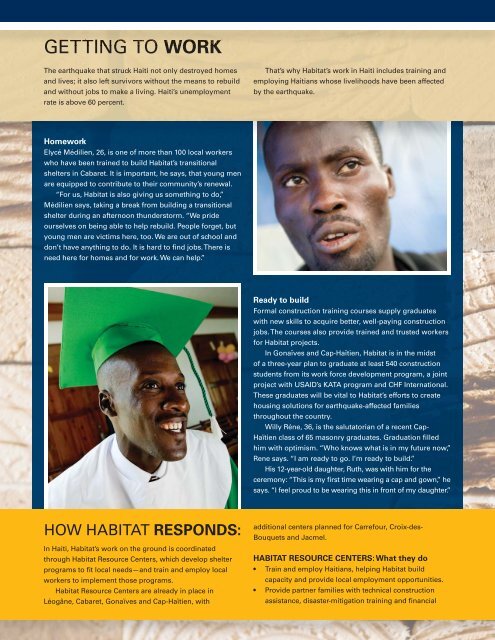PROGRESS IN HAITI
PROGRESS IN HAITI - Habitat for Humanity Canada
PROGRESS IN HAITI - Habitat for Humanity Canada
Create successful ePaper yourself
Turn your PDF publications into a flip-book with our unique Google optimized e-Paper software.
GETT<strong>IN</strong>G TO WORK<br />
The earthquake that struck Haiti not only destroyed homes<br />
and lives; it also left survivors without the means to rebuild<br />
and without jobs to make a living. Haiti’s unemployment<br />
rate is above 60 percent.<br />
That’s why Habitat’s work in Haiti includes training and<br />
employing Haitians whose livelihoods have been affected<br />
by the earthquake.<br />
Homework<br />
Elycé Médilien, 26, is one of more than 100 local workers<br />
who have been trained to build Habitat’s transitional<br />
shelters in Cabaret. It is important, he says, that young men<br />
are equipped to contribute to their community’s renewal.<br />
“For us, Habitat is also giving us something to do,”<br />
Médilien says, taking a break from building a transitional<br />
shelter during an afternoon thunderstorm. “We pride<br />
ourselves on being able to help rebuild. People forget, but<br />
young men are victims here, too. We are out of school and<br />
don’t have anything to do. It is hard to find jobs. There is<br />
need here for homes and for work. We can help.”<br />
Ready to build<br />
Formal construction training courses supply graduates<br />
with new skills to acquire better, well-paying construction<br />
jobs. The courses also provide trained and trusted workers<br />
for Habitat projects.<br />
In Gonaïves and Cap-Haïtien, Habitat is in the midst<br />
of a three-year plan to graduate at least 540 construction<br />
students from its work force development program, a joint<br />
project with USAID’s KATA program and CHF International.<br />
These graduates will be vital to Habitat’s efforts to create<br />
housing solutions for earthquake-affected families<br />
throughout the country.<br />
Willy Réne, 36, is the salutatorian of a recent Cap-<br />
Haïtien class of 65 masonry graduates. Graduation filled<br />
him with optimism. “Who knows what is in my future now,”<br />
Rene says. “I am ready to go. I’m ready to build.”<br />
His 12-year-old daughter, Ruth, was with him for the<br />
ceremony: “This is my first time wearing a cap and gown,” he<br />
says. “I feel proud to be wearing this in front of my daughter.”<br />
HOW HABITAT RESPONDS:<br />
In Haiti, Habitat’s work on the ground is coordinated<br />
through Habitat Resource Centers, which develop shelter<br />
programs to fit local needs—and train and employ local<br />
workers to implement those programs.<br />
Habitat Resource Centers are already in place in<br />
Léogâne, Cabaret, Gonaïves and Cap-Haïtien, with<br />
additional centers planned for Carrefour, Croix-des-<br />
Bouquets and Jacmel.<br />
HABITAT RESOURCE CENTERS: What they do<br />
• Train and employ Haitians, helping Habitat build<br />
capacity and provide local employment opportunities.<br />
• Provide partner families with technical construction<br />
assistance, disaster-mitigation training and financial
















